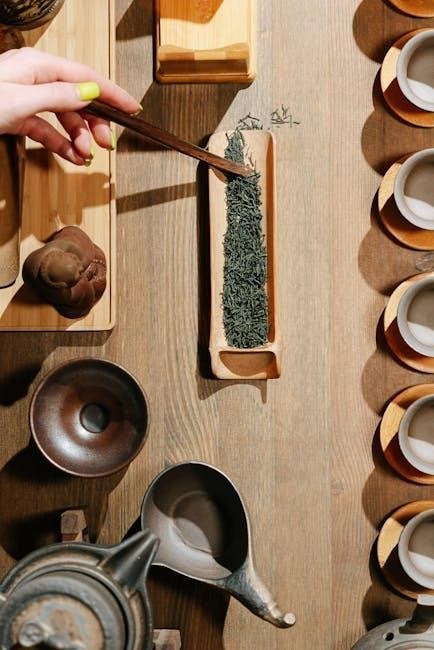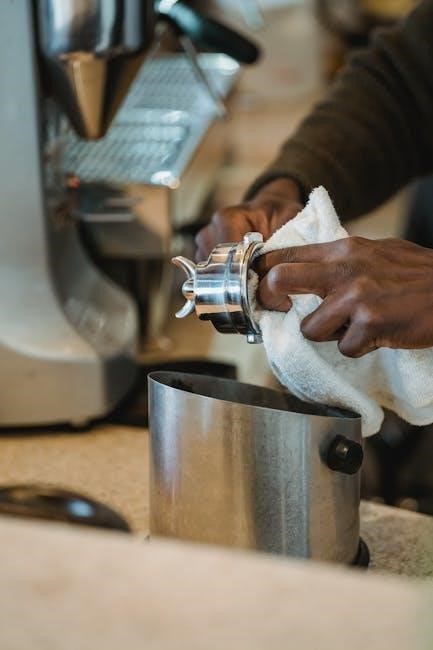Mead, or “honey wine,” is a fermented beverage made from honey and water. Simple to brew, it offers endless flavor possibilities with fruits, spices, or herbs added for complexity.
What is Mead?
Mead, often called “honey wine,” is an ancient fermented beverage made from honey, water, and yeast. It can be still, carbonated, or sparkling, ranging from dry to sweet. Unlike beer, mead doesn’t require malted grains, making it a simpler base for experimentation with flavors like fruits, spices, or herbs. The fermentation process transforms honey’s sugars into alcohol, resulting in a drink with an ABV similar to wine. Mead’s versatility allows for endless creativity, appealing to both novice brewers and experienced enthusiasts. Its smooth, honey-forward profile makes it a unique and rewarding craft to explore.
History and Popularity of Mead
Mead is one of humanity’s oldest alcoholic beverages, with a history dating back thousands of years. Ancient cultures in Europe, Africa, and Asia fermented honey to create this drink, often revered for its flavor and medicinal properties. Traditionally, mead was a staple in Viking and medieval societies, where it was celebrated in rituals and feasts. In modern times, mead has experienced a resurgence in popularity, driven by the craft brewing movement and the desire for unique, artisanal beverages. Its simplicity and versatility make it a favorite among home brewers, contributing to its growing global appeal and varied flavor profiles.
Equipment Needed for Making Mead
Essential tools include a fermenter, airlock, and siphon. Secondary vessels and bottles are also necessary for clarifying and storing the mead.
Essential Tools and Vessels
A 1-gallon fermentation bucket is ideal for beginners, ensuring easy monitoring of the process. An airlock is crucial to allow gases to escape while preventing contamination. A siphon and racking cane are necessary for transferring mead between vessels without introducing oxygen. Secondary fermentation vessels, like glass carboys, help clarify the mead. Bottles with tight-fitting lids are needed for long-term storage. All equipment should be food-grade and sanitized thoroughly before use to ensure a healthy fermentation environment and prevent spoilage. These tools form the foundation for crafting high-quality mead at home.
Sanitization and Cleaning Equipment
Sanitization is critical to prevent contamination and spoilage in mead-making. Use a sanitizer like campden tablets or bleach solution to sanitize all equipment, including the fermentation bucket, airlock, and utensils. Rinse thoroughly after sanitizing to remove any residue. Cleaning equipment before sanitization ensures effectiveness; use hot water and mild detergent to remove any residue or debris. Sanitize all items just before use to maintain sterility. This step is essential for a healthy fermentation process and to produce high-quality mead. Regular sanitization helps prevent unwanted flavors and ensures the mead ferments cleanly and effectively.
Ingredients for Crafting Mead
Honey is the primary ingredient, with water and yeast essential for fermentation. Nutrients and optional additions like fruits, spices, or herbs enhance flavor and complexity.
Honey Selection and Quality
Selecting high-quality honey is crucial for crafting exceptional mead. Choose raw, pure honey to preserve its natural enzymes and aroma. Clover and orange blossom honeys are popular for their mild, floral flavors, while wildflower or manuka honeys offer richer, earthier notes. Avoid ultra-processed honey, as it lacks the complexity needed for fermentation. The honey’s quality directly impacts the mead’s character, so invest in a reputable source. Proper storage and handling ensure the honey remains pristine for brewing. Experimenting with different varieties can yield unique flavor profiles, making honey selection a key creative step in mead-making.
Yeast and Nutrients
Yeast is a key component in mead production, converting sugars into alcohol. Rehydration is recommended before pitching to ensure optimal viability. Popular strains like D47 are ideal for mead, offering balanced fermentation. Nutrients are essential for healthy yeast growth, preventing deficiencies that could stall fermentation. Adding yeast nutrients ensures proper cell function and metabolism, promoting a clean, efficient process. Splitting nutrient additions during fermentation can enhance yeast health and fermentation stability. Proper yeast and nutrient management is critical for achieving desired flavor profiles and avoiding off-flavors in your mead.
Water and Additional Ingredients
Water is a fundamental component in mead, serving as the base for the must. Clean, filtered water is recommended to avoid impurities affecting flavor. Additional ingredients like fruits, spices, or herbs can enhance complexity, allowing for unique variations. Acid adjustments and tannins may be added to balance pH and mouthfeel. Energizers and Campden tablets are optional, aiding fermentation and preventing spoilage. These ingredients are added at specific stages to ensure proper integration and fermentation efficiency, helping to create a smooth, flavorful mead.

Sanitization Process
Sanitizing equipment is crucial to prevent contamination and ensure a clean fermentation. Use bleach or Campden tablets to sanitize all tools and vessels before use.
Importance of Sterilization
Sterilization is essential to prevent contamination and ensure a clean fermentation process. Wild yeasts, bacteria, and other microorganisms can spoil the mead, leading to off-flavors or complete failure. Proper sterilization eliminates these risks, safeguarding the must and equipment. Without sterilization, unwanted organisms can thrive, ruining the batch. This step is critical for maintaining the integrity of the mead’s flavor and aroma, especially since honey can harbor natural yeasts that may not align with the desired fermentation profile. Cleanliness is the foundation of successful mead-making, making sterilization a non-negotiable step in the process.
Best Practices for Sanitizing Equipment
Sanitizing equipment is crucial for preventing contamination. Use food-grade sanitizers like Star San or Campden tablets, ensuring all surfaces come into contact with the solution. Rinse equipment thoroughly in hot water before sanitizing. Allow the sanitizer to sit for the recommended time, typically 10–30 minutes, to effectively kill microorganisms. Avoid using bleach, as it can leave residues and harm fermentation. After sanitizing, rinse with clean water if necessary, then dry equipment with a clean, lint-free cloth or let it air dry; Proper sanitization ensures a clean environment for fermentation, reducing the risk of spoilage and off-flavors in your mead.

Basic Mead Brewing Process
Dissolve honey in warm water, mix with acid, tannin, energizer, and Campden. Rehydrate yeast before pitching. Monitor and control fermentation temperature for optimal results.
Preparing the Must
Start by dissolving honey in warm water to create the must. Add acid and tannin for balance and stability. Include optional energizer and Campden to prevent contamination and aid yeast. Mix thoroughly to ensure even distribution. Avoid boiling to preserve honey’s delicate flavor. Sanitize the must with Campden to eliminate wild yeast and bacteria. Allow the mixture to sit for 24 hours before pitching yeast, ensuring additives are fully incorporated. This step is crucial for a clean fermentation process and optimal flavor development. Proper preparation of the must sets the foundation for a successful mead brew.
Rehydrating Yeast
Rehydrating yeast is a crucial step before pitching. Mix a small amount of warm water (around 90-100°F) with a little honey or a yeast rehydration solution. Let it sit for 5-10 minutes until creamy, then gently fold in the yeast. Allow it to hydrate fully for another 5-10 minutes. This step ensures yeast viability, reduces contamination risk, and promotes a vigorous fermentation. Proper rehydration is essential for a healthy start for your mead.
Initial Fermentation Setup
After preparing the must, transfer it to a sanitized fermenter. Ensure the vessel is airtight and equipped with an airlock to allow CO2 to escape while preventing contamination. Pitch the rehydrated yeast into the must, gently stirring to distribute evenly. Seal the fermenter and monitor for signs of fermentation, such as bubbles in the airlock. Maintain a consistent temperature (68-72°F for most yeasts) to promote healthy yeast activity. Keep the setup away from direct sunlight and drafts. Regularly inspect the airlock for proper function and cleanliness to ensure a smooth fermentation process.

Fermentation and Monitoring
Mead fermentation is monitored using an airlock. Bubbles indicate active fermentation. Degassing releases excess CO2. Regular checks ensure healthy progress and prevent contamination risks.
Active Fermentation Process
Active fermentation begins within 24-48 hours, marked by bubbles in the airlock. This phase lasts 2-3 weeks, with yeast converting sugars into alcohol. Monitor the airlock regularly to ensure proper gas release. Maintain consistent temperatures between 68-72°F for optimal yeast activity. Degassing is crucial to prevent excessive CO2 buildup; gently stir the must to release trapped gases. Fermentation progress can be tracked by observing bubble frequency and aroma changes. Keep the vessel sealed to prevent contamination. Patience is key, as active fermentation lays the foundation for a smooth, balanced mead. Proper monitoring ensures a healthy, vigorous fermentation process.
Using an Airlock
An airlock is essential for mead brewing, allowing CO2 to escape while preventing contaminants from entering the fermenter. Install the airlock immediately after pitching the yeast. Fill it with water or sanitizer to create a barrier; During active fermentation, bubbles will form and rise through the airlock, indicating healthy yeast activity. Monitor the frequency of bubbles to gauge fermentation progress. A slower bubble rate suggests fermentation is nearing completion. Keep the airlock in place until fermentation is complete to ensure cleanliness and prevent spoilage. Regularly check the airlock for proper function and replace the liquid as needed.
Degassing and Monitoring Progress
Degassing involves releasing built-up CO2 from the mead to prevent over-carbonation and promote a smooth fermentation. Gently swirl the fermenter or use a degassing tool to release trapped gases. Monitor the airlock for bubble frequency, which slows as fermentation progresses. Track specific gravity with a hydrometer to measure sugar conversion and alcohol content. Regularly taste the mead to assess flavor development and clarity. Proper monitoring ensures a balanced and refined final product, helping you determine when it’s ready for racking or bottling. Consistent checks prevent off-flavors and ensure a successful brew. Adjustments can be made based on observations during this critical phase.

Aging and Bottling
Aging allows the mead to mature, clarifying and enhancing its flavor profile. After fermentation completes, transfer the mead to bottles for long-term storage, ensuring proper sealing and conditions for preservation.
When to Rack the Mead
Racking involves transferring mead from one vessel to another to clarify and separate it from sediment. This process is typically done after active fermentation subsides, usually 2-4 weeks later. Use an airlock to monitor fermentation progress; once bubbles slow significantly, it’s time to rack. Ensure all equipment is sanitized to prevent contamination. Rack the mead gently to avoid introducing oxygen or stirring up the sediment. Repeat racking every few months during aging to further clarify and mature the mead, enhancing its flavor and aroma before bottling;
Adding Flavor Variations
Add unique twists to your mead by experimenting with fruits, spices, or herbs. Introduce ingredients like berries, citrus, cinnamon, or vanilla during fermentation or aging for distinct flavor profiles. For example, add fruits after initial fermentation begins or steep spices during aging. The possibilities are endless, allowing you to craft a mead that suits your taste preferences. Keep it simple or get creative—flavor variations enhance the character of your brew without complicating the process. This step is optional but offers a fun way to personalize your mead and explore new tastes.
Bottling and Long-Term Storage
Bottling and long-term storage are crucial steps in mead crafting. Once fermentation is complete, transfer the mead to glass bottles with tight-fitting seals. Store them in a cool, dark place to preserve flavor and aroma. Allow the mead to age for at least six months, though some varieties benefit from years of storage. The longer it ages, the smoother and more complex it becomes. Be patient, as proper aging enhances the character of your mead, making it well worth the wait.

Troubleshooting Common Issues
Common issues in mead making include stuck fermentation, off-flavors, or over-oxidation. Monitor temperature, ensure proper sanitization, and adjust nutrients or yeast to resolve these problems effectively.
Identifying and Solving Fermentation Problems
Fermentation issues, like a stuck process or off-flavors, often stem from improper yeast rehydration, insufficient nutrients, or poor temperature control. Rehydrate yeast separately and ensure temperatures stay between 65-75°F for optimal activity. If fermentation stalls, check for nutrient deficiencies and consider adding a yeast energizer. Off-flavors can arise from contamination or over-oxidation, so maintain proper sanitization and monitor airlock activity. Regularly degas the mead to release CO2, preventing pressure buildup. Adjusting techniques and closely following TOSNA guidelines can help resolve these common problems, ensuring a smooth and successful fermentation process for your homemade mead.
Common Mistakes and How to Avoid Them
One common mistake is not rehydrating yeast before adding it to the must, which can lead to poor fermentation. Always rehydrate yeast in warm water with a little sugar. Another error is using too much honey, resulting in overly sweet mead. Start with lower ABV goals and adjust later. Contamination is a major risk, so ensure all equipment is sanitized thoroughly. Overlooking temperature control can disrupt yeast activity, so keep fermentation between 65-75°F. Lastly, not degassing regularly can cause off-flavors and slow fermentation. By following these tips, you can avoid these pitfalls and brew a delicious, balanced mead successfully.
Making mead at home is a rewarding and versatile craft that combines simplicity with endless creativity. With the right tools, ingredients, and attention to detail, you can create delicious, unique meads tailored to your taste. Remember to sanitize thoroughly, monitor fermentation, and be patient during aging. Experimenting with flavors and techniques will enhance your skills over time. Whether you prefer traditional or modern recipes, mead offers a journey of discovery and enjoyment. Cheers to your mead-making journey—may every batch be better than the last!
